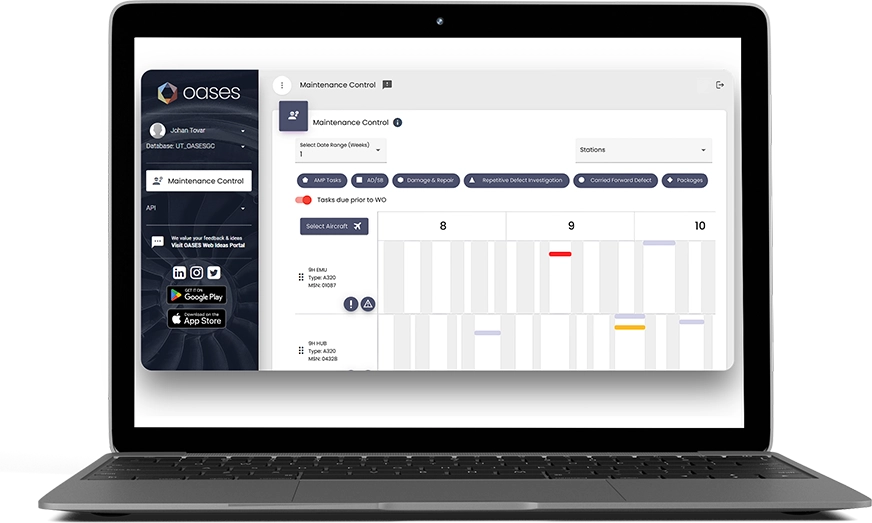Aircraft technical records play a pivotal role in ensuring the safety and reliability of operations. However, the traditional paper-based approach to managing these records has always posed numerous challenges for airlines, MRO, and CAMO operators.
Research by Gartner shows that 91% of companies are implementing some form of digital initiative, with 87% of senior business leaders saying digitisation is a priority. But digitisation is not exactly new and – while the earliest digital tools were extremely helpful when introduced – they’re not fit for purposes in terms of today’s requirements.
So, in this article, we will explore the importance of digitisation, how it has developed, and what operators should be looking for in a modern solution.
Technical Records in the Old Days
Before we had computerised systems, maintaining a fleet’s aircraft technical log was a painstaking, manual process. Each aircraft had a set of paper-based logbooks including the technical log, which recorded technical and maintenance-related information.
After each flight, pilots were responsible for making entries in the technical log and any issues or anomalies observed during. A copy of that information had to be left with ground staff which then needed to be scanned or faxed to various departments.
Maintenance technicians and engineers would review the entries and carry out the necessary inspections, repairs, or maintenance activities, and manually record all activities performed in the technical log.
The paper logs had to be physically stored and carefully handled, and significant storage space was required. Information from the logs sometimes needed to be transferred to other types of records and this was done manually – a time-consuming process that was prone to errors.
The Benefits of Electronic Tech Logs
The shift to computerised systems including the Electronic Tech Log (ETL) significantly streamlined the processes above, reducing many operational costs. With an ETL, pilots record data digitally from the cockpit using a built-in computer or portable device. This brings the following benefits:
- Improved accuracy: Digitisation eliminates the risk of transcription and readability issues, ensuring that records remain accurate.
- Easy accessibility: Digital records facilitate quick and efficient data retrieval, which streamlines decision-making processes, reducing aircraft downtime. With an ETL, it’s easy to get an up-to-date overview of your entire fleet at any moment.
- Enhanced security: Digital records are secure and can be protected through robust encryption and access control measures, ensuring that sensitive information remains confidential and safeguarded from unauthorised access – much more effective than preventing access to filing cabinets with physical locks that can be easily breached.
- Compliance: The industry has comprehensive regulatory demands, and organisations are required to maintain meticulous records. The need for real-time data access and updates has become essential to comply with stringent regulations and demonstrate compliance to authorities.
- Efficient line maintenance: Having data about defects and tasks at one’s fingertips means engineers don’t have to waste time going back and forth between line maintenance offices to get information or update them. As such, planning is easier and tasks get completed on time.
- Sustainability: Naturally, a paperless techlog is better for our planet and is one of several steps in climate change adaptation.
How Does MRO Software Take Things Further?
Changing from paper records to an ETL should be top priority for any airline, but it doesn’t solve all the efficiency problems they face every day.
Legacy systems were limited in functionality compared to what we have today, and even with information being stored digitally, different systems weren’t connected. This meant that the same data had to be entered into multiple systems separately, and there were still situations where information had to be passed back and forth between different teams manually.
So, while the risks of paper copies getting lost or damaged were no longer relevant, processes were still very time-consuming and data from different departments or stages of the MRO process was not easily consolidated. There was also the issue of having to manually convert files into different formats for archiving.
Back then, the software primarily focused on basic data entry and storage and had limited capabilities for analysis, forecasting, or real-time tracking. And of course, not all processes were digitised – many still required manual input or intervention.
Also, when ETLs are connected to legacy software, there’s always the risk of data loss or corruption if hardware is damaged or software crashes.
Fast-forward to the modern, cloud based MRO solutions we have today and the picture is very different.
Benefits of Cloud Based MRO Software
Cloud based MRO software makes the process of logging aircraft data run smoothly for every flight – not only data entered into the ETL, but all data gathered from sensors throughout the plane.
Data is stored in a centralised database and is automatically backed up so that no matter what happens to your hardware, your data is always secure and accessible in the cloud.
In addition, whoever or whatever system needs to access it can do so with ease from any location. It connects your whole organisation and ensures everyone has accurate, up-to-date information at all times.
With modern systems, many processes are automated, increasing efficiency in ways that was never possible before. The software is also regularly updated with minimal disruption (often automatically), ensuring access to the latest features and security enhancements.
Modern MRO software comes with advanced features like predictive maintenance, real-time tracking, automated alerts, and advanced analytics. It also offers seamless integration with a variety of other platforms and databases, allowing for connected ecosystem encompassing the entire MRO process.
How OASES Cloud Makes This Possible
OASES Cloud is the single, cloud based repository where all of our customers’ data is securely stored – with minimal effort on their part. And it’s the glue that holds all modules of our software together, letting them connect and share data. It’s easily scalable according to customer needs, supporting growing and large airlines alike.
Despite many other technical leaps such as inspection drones, the aviation industry has been slow to adopt paperless processes when it comes to maintenance. Among the main barriers to cloud adoption are a lack of staff resources (50%) and difficulty integrating it with a company’s existing systems.
It’s easier to make the transition with a supportive partner that handles the process from start to finish. That’s why the OASES implementation process starts with in-depth planning, followed by a secure cloud migration, before configuring the solution in line with each customers’ unique requirements.
Conclusion
The aviation industry is embracing modernisation, and the replacement of technical records with ETLs is a key part of this change.
As well as eliminating the risk of data loss or transcription errors, cloud based solutions centralise all data, automate processes and provide advanced analytical tools – which was once a distant possibility. As a leading MRO software provider, we are helping airlines, MROs and CAMOs to make this transition seamlessly. The result? Greater efficiency, greater compliance, and greater aircraft safety and reliability. To book a demo, contact us today.




